

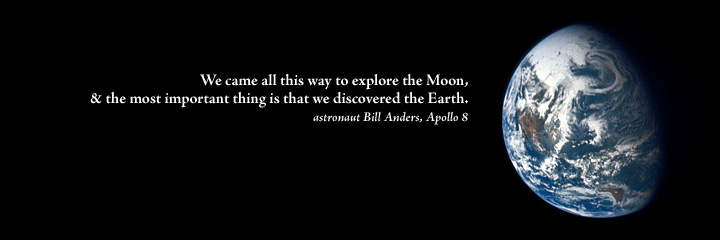
NASA astronaut photograph AS10-34-5036.
Say NASA, and many images may come to mind: a white-clad man leaping awkwardly, joyfully across the surface of the moon; probes gliding into the depths of the solar system, sending back pictures of distant worlds; two tenacious robots exploring the red rock surface of Mars, uncovering evidence of a wet past; the horrifying disintegration of the Challenger and Columbia space shuttles.
For some, another image comes to mind: a tiny blue and white planet, a fragile oasis in the black vastness of space. Recalling his thoughts while orbiting the Moon during the landmark Apollo 8 mission, astronaut Bill Anders said, “We came all this way to explore the Moon, and the most important thing is that we discovered the Earth.” (Quoted in The Societal Impact of Space Flight, p.55.)
Venturing into space has taught us about our Sun, solar system, and the universe beyond, but it has also given us a new perspective on our home planet, Earth. In 2008, as NASA celebrates 50 years of existence as an agency and 40 years since man first left Earth’s orbit, the Earth Observatory asked a number of Earth scientists what unique insights space flight has given us about Earth. Some emphasized revolutionary technology, others mentioned specific discoveries and observations of important Earth events, while others highlighted the power of satellite images to make us understand the interconnectedness of people and places around the globe. A selection of their responses follows.
Piers Sellers remembers admiring the intricate details visible from the orbiting space shuttle. “It was like someone spent forever building a tiny model.” He was surprised by the thinness of the atmosphere, a delicate mist glued to Earth’s surface, and delighted in seeing the edges of the clouds curl up towards space, something that isn’t obvious in two dimensional satellite images.
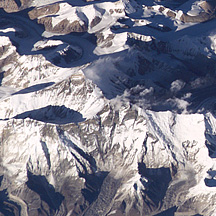


Astronauts and cosmonauts have taken thousands of photographs of the Earth, including Mt. Everest (left), Cuba (center), and clouds over South America (right). (NASA astronaut photographs ISS008-E-6146, ISS017-E-14060, and ISS017-E-13859.)
Apart from letting humanity see Earth differently than ever before, the view from space has also expanded our understanding of how the planet works, and just in time to grasp the impact humanity is having on the planet and its climate system, says Sellers. For the first time, we see our planet as a whole, a system of intricately connected parts that interact—and can be perturbed—in ways humans had not previously glimpsed. For example, the view from space was necessary to understand how much carbon moves through ocean and land plants every year during photosynthesis, says Sellers. “You need a global view to understand global processes like the carbon cycle.”
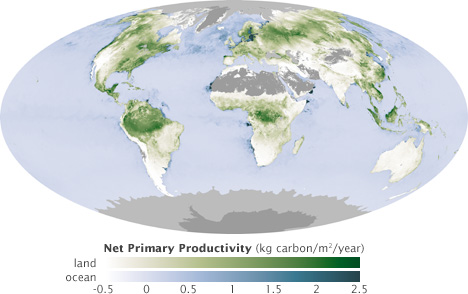
We view Earth now as a planet, not unlike Mars or Venus. Prior to the advent of space exploration, we could only look at the planets from a great distance but now robotic spacecraft like rovers and landers are enabling us to observe them up close. For Earth it was quite the opposite. Heretofore, we could only observe our immediate surroundings like lands, oceans, clouds, mountains, etc. The view from space allows us to observe the entire Earth as a planet.
Scientifically, NASA initiated the concept of “Earth System Science” to describe that the Earth’s climate system is an interactive system with many feedbacks [connections]. What happens in one part affects the rest. NASA went on to collect individual measurements like sea surface temperature, outgoing radiation, soil moisture, etc. and integrated measurements from different sounders and imagers to study the feedbacks among the various individual measurements.
My favorite image of Earth is the composite view of Earth at night, which shows the light over the USA East and West Coasts, Europe, Japan and along the Nile river. It is one of very few space observations that demonstrates “intelligent life exists on our planet.”

The view of city lights at night is one of very few space observations that demonstrates “intelligent life exists on our planet,” says Moustafa Chahine. On the other hand, says Marc Imhoff, “nothing shows how much impact we are having as a species on this planet better than that composite image.”
(NASA image by Robert Simmon, based on MODIS Blue Marble and Defense Meteorological Satellite Program city lights data.)
We have come to realize how thin and fragile our atmosphere is, how finite our resources are, and how interconnected we are with everyone else on the planet. Scientifically, the view from space has enabled us to see how human activities can interact with natural cycles to cause important changes. For the first time, we have observed the melting of ice and sea level rise, and how ocean circulation works.
My favorite view of Earth from space is the global city lights at night. Nothing shows how much impact we are having as a species on this planet better than that composite image.
As a geologist, my perspective of the Earth as a planet in space did not change with the opportunity to view it on the way to the Moon. But I was impressed by how well I could observe and forecast weather patterns during those three days, with the help of a 10X monocular. The Apollo views of the full Earth disk have stimulated thought on the value of continuous monitoring the full disk from the Moon as inherently different than the views from Earth orbit.

Apollo astronauts captured a series of over 700 photographs of the Earth’s disk on their way to and from the moon. A crew member of Apollo 10 snapped this shot while he was 100,000 nautical miles (185,000 kilometers) from Earth on May 18, 1969. (Astronaut Photograph AS10-34-5026.)
First of all, seeing Earth from space has a psychological impact on human’s awareness of the planet we are all sharing. It heightens our sense of the global impact of both natural processes and human activities.
Scientifically, observing Earth from space has revolutionized our understanding of Earth as a system. For the first time we are able to see how the world’s landscape has been changing on a scale not amenable to ground-based observations. We begin appreciating the ocean’s effects on weather on land through dramatic events like El Niño. We are seeing the minute change of global sea level as well as the rapidly disappearing Arctic sea ice as a consequence of global warming. By comparing measurements of topography taken at different times, we can delineate the slow change of the surface of Earth that results from the tectonic movement of Earth’s crust. We are even able to detect the minute change of Earth’s gravity field caused by the melting of ice on Greenland and Antarctica as well as by the seasonal change of ground water on land.
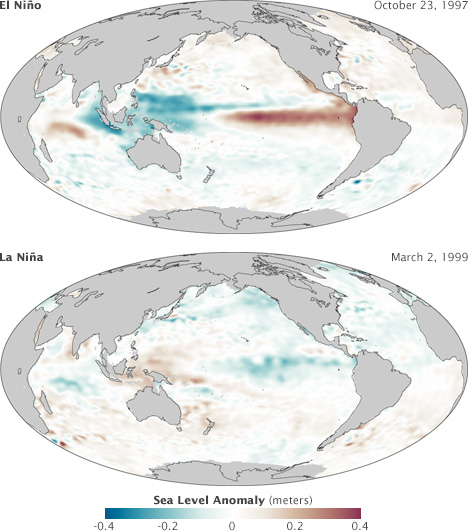
El Niño and La Niña are characterized by large-scale changes in equatorial Pacific Ocean currents. The TOPEX/Poseidon satellite monitored changes in sea-surface height during the record 1997 El Niño and subsequent 1999 La Niña. In October 1997, warm water piled up off the west coast of South America, raising sea level (red), while in March 1999, the cool waters of La Niña dropped the sea level below normal (blue). (Maps by Robert Simmon, based on TOPEX/Poseidon data from the World Ocean Circulation Experiment.)
Viewing Earth from space enabled the following scientific discoveries, not in ranked order and surely biased by my own perspective:

My favorite image is a rather poor quality image by today’s standards. It made the cover of Eos (an Earth science journal) because it was the “Ah-Hah!” image that gave us the very first view of fast moving ice streams in the midst of the Antarctic ice sheet. We could identify them because their surfaces were rougher (bumpier) than the much slower flowing ice on either side. Prior to this image we only knew they were there, but we had no effective means to map their extent. Seeing this image come up on the screen and knowing I was looking at something significant that no one had ever seen before remains one of the most memorable days of my scientific career.
From my particular field of ice sheet dynamics, satellite observations have given us the ability to see how fast ice sheets move, how the ice funnels into outlet glaciers, and (from the ability to see subtle flow features) tell how the ice flowed in the millennial past.
Satellite data have revolutionized glaciology. It’s as simple as that. We know more about what is going on at the remote high latitudes and high altitudes from the satellite observations of the past 50 years than we would have every known from hundreds of years of ground observations.

Colors indicate the speed of flowing ice in Antarctica’s outlet glaciers. The glaciers move relative slowly (one or two meters per year) in the interior and speed up tremendously as they approach the sea. This image includes data from several orbiting radar instruments. (NASA image courtesy Eric Rignot, Jet Propulsion Laboratory.)
Not a person alive in the U.S. has gone without seeing geosynchronous images of clouds and the Earth from space. These are used in every TV weather forecast throughout the nation and elsewhere in the globe. Highlights are often shown during hurricane season and during severe storms or blizzards that ground aircraft or cripple regions of the country.

Hurricane Ike made landfall over Galveston Island on September 13, 2008. The GOES-12 satellite monitored the storm from its birth in the mid-Atlantic until its demise over the central United States. (NASA Image courtesy GOES Project Science Office.)
A plethora of satellite imagery document natural (or human-caused) disasters, such as tsunamis, hurricanes and typhoons, fires, severe floods, blizzards, droughts, and wars, around the world. The interconnection between sometimes distance places and individual nations becomes clear through satellite imagery.
Views of calving glaciers, sea ice retreat, and other natural and human-influenced changes have also started to seep into the public’s consciousness.
Though not initially discovered from space, seasonal and annual fluctuations of ozone concentration, especially in the important Antarctic ozone hole, have been monitored and studied extensively with the aid of space-based observations.

The Total Ozone Mapping Spectrometer revealed the size and depth of the ozone hole that first formed over Antarctica in the 1980s. Scientists used the data to demonstrate the need for a ban on ozone-destroying chemicals, which went into effect in 1989. (Images and data courtesy NASA Ozone Hole Watch.)
The view from space has enabled the observation of:
I like the view of ship tracks in the eastern Atlantic off the Iberian Peninsula. The phenomenon of ship tracks is a clear signature of how burning fossil fuels modifies clouds. A cloud modified by the small particles released when fossil fuels are burned is brighter when viewed from the vantage point of space.

Ship tracks off the Atlantic coast of Europe. (NASA image by Jacques Descloitres, MODIS Rapid Response Team.)
My favorite picture, the one I start my public talks with, is the Earth taken from the Moon by the Apollo astronauts. The Earth looks so alone and fragile.

Earth from the Apollo 8 Command Module on December 26, 1968. (NASA astronaut photograph AS08-14-2383.)
Until satellites, most terrestrial ecologists could only study their own backyard. Twenty years ago, more than 90 percent of the papers in the journal Ecology were on studies from 0.1 hectare plots. Satellites gave us a continental and global look at the biosphere where we could compare and contrast ecosystems all over the world and monitor change. Change detection of virtually all the key global habitability indicators would have been impossible without the repeatability and consistency of the satellite record. I can sit at my computer and effectively study any ecosystem on Earth anywhere. That’s pretty cool.

Satellites make it possible to regularly collect data over even the most remote places. These two Landsat images, acquired in 1984 and 2005, show the growth of Machadinho D’oeste in the Brazilian state of Rondonia.The town is at bottom center, surrounded by cleared rainforest. (NASA images by Robert Simmon, based on Landsat data from the University of Maryland Global Land Cover Facility.)
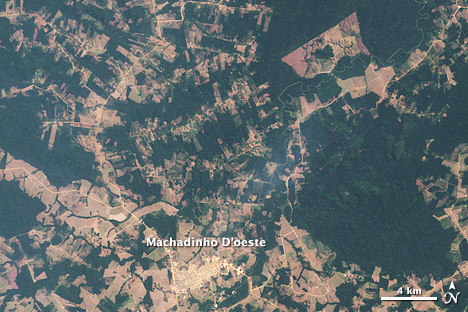
Satellites have been magnificent in terms of providing us with a global view of what’s happening on our planet. This has been tremendously important in numerous fields of Earth science. For instance, in sea ice studies, it has allowed us to monitor the full Arctic and Antarctic sea ice covers every one or two days for almost the entire period since late 1978. This has provided us with detailed information about the strongly decreasing Arctic sea ice cover and slightly increasing Antarctic sea ice cover since 1978 that we simply would not have had without satellite data.

Satellites have mapped the extent of Arctic Sea since 1979. In the past decade the area of ice during September (annual minimum) has declined from over 6 million square kilometers to a record low of 4.3 million square kilometers in 2007. (NASA maps by Jesse Allen and Robert Simmon, based on data from the National Snow and Ice Data Center.)
The book Our Changing Planet: The View From Space is full of impressive satellite imagery. Some images are global, revealing fascinating aspects of the Earth system that would not be apparent without the global or near-global view. For instance, the global image of lightning flash rate from eight years of satellite data shows that lightning is overwhelmingly more frequent over land than over oceans. Other views are impressive for the changes they reveal, such as the sequence of three images showing the crumbling of the Larsen B ice shelf along the Antarctic Peninsula in 2002. Still other images are impressive for the level of detail they present, such as an image of San Francisco showing not just the buildings (and their shadows) but also roads and parking lots and specks revealing cars and trucks along the roads and in the parking lots.

Thunderstorms that form over land are more likely to produce lightning than storms that form over the open ocean, and 90% of the world’s lightning flashes occur over land. This maps shows the frequency of lightning flashes per square kilometer per year from April 1995–February 2003. (NASA map by Marit Jentoft-Nilsen, based on data from the Global Hydrology Resource Center.)
Until recently, humanity has only perceived Earth’s story in small chapters, a series of short scenes as we have observed the sky, land, water, and life in our backyard. As we watch our planet from space, the scenes flow together, and unconnected narrative becomes an epic novel in which all players have a part. We are coming to understand that all parts of our planet are connected, that a fallen forest or a melting glacier in a faraway place touches the rain that falls nearby, that the gases that rise into the atmosphere don’t disappear, that the seemingly small things we do from day to day add up to big changes in the Earth system.
The Earth Observatory exists to tell both Earth’s story and the stories of people seeking to understand Earth as we look back from space. It also exists to share the great beauty of the unique planet on which we live. Only from space can we appreciate the beauty of a vast phytoplankton bloom coloring the ocean with fanciful swirls of green and blue, or watch the slow southward creep of orange down the folds of the entire Appalachian Mountain Range as fall turns to winter. From space, the symmetry of a powerful hurricane or a plume of pale dust reaching over the dark ocean is beautiful.

Fall colors tint the hilltops flanking the Susquehanna River valley in central Pennsylvania. Pale, recently harvested fields line the valley floors between ridge lines. This natural-color image was acquired on October 21, 2001, by Landsat-7. (NASA image by Robert Simmon, based on Landsat data from the University of Maryland Global Land Cover Facility.)
When NASA marked its 50th anniversary on July 29, 2008, it had 21 Earth-observing satellites in orbit. NASA’s rich history of observing Earth from space continues. In 2009, two more missions are scheduled to launch. The Orbiting Carbon Observatory will observe carbon dioxide concentrations in the atmosphere, and Glory will monitor aerosols like black carbon soot and track changes in the amount of energy entering the atmosphere from the Sun. NASA is developing and studying new missions in response to the National Research Council’s 2007 Decadal Survey for Earth Science—a once-a-decade report that prioritizes Earth science questions and makes recommendations for the missions NASA and its partners should undertake in the coming decade to help answer them. These missions will join those already in orbit to teach us more about Earth and give us a greater appreciation of its complex beauty.